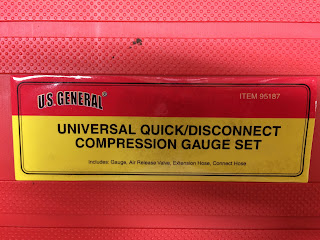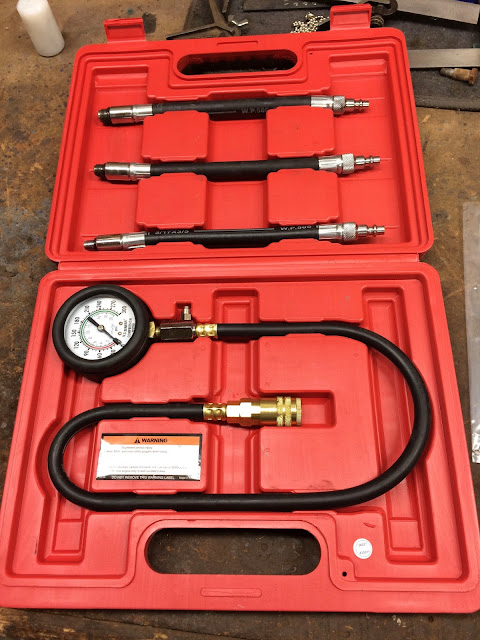CT90 Testing Issue With Harbor Freight Compression Tester and a Correction Factor to Fix the Issue
One of the most basic things you can do to check the health of your CT90 is do a compression check. The compression tester I own is one I picked up at Harbor Freight made by U.S. General. The compression tester comes as a set that includes the basic gauge and attached hose along with three adapters that fit most typical spark plug applications, including the one that fits the CT90 spark plug hole.
While I have never had any issues using this compression tester on any of my cars, when I have used it on my CT90's it always seemed to give me an abnormally low reading even on bikes where I had just redone the top end with a new piston, freshly bored cylinder, and lapped and correctly adjusted valves.
I also noticed while spending some time on various on-line sites that other people were having the same issue with this compression tester, so I decided to spend a little time and try to better understand the low results being seen with the use of this compression tester, especially with its use on CT90 size engines.
I explain in more detail below, but the conclusion I reached by doing a little investigation and math is that this compression tester will give results that are only about 60% of the actual theoretical compression reading for a CT90 with a spark plug installed. So now whenever I use this tester on my CT90's I use a correction factor where I multiply the reading I see on the gauge by 1.66 to get the real compression reading for my bike.
Here are a couple pictures of the compression tester that I picked up from Harbor Freight.
For a fairly low price, the compression test kit is actually a pretty good deal considering the gauge, hose, and adapters that are included.
The unique feature about this compression tester is that it includes various adapters that are sized for the most commonly used spark plugs where the adapters are attached to the hose coming from the gauge using a typical quick disconnect fitting like is used on most air tools and hoses.
I have broken down/disassembled the components of the compression tester and adapter that would be used for a typical compression test in the photo below.
There are four main subcomponents:
1. The adapter - The adapter is a straight hose assembly with a threaded feature at one end to screw into the spark plug hole and a air hose type fitting at the other end to attach to the quick disconnect.
2. The quick disconnect - The quick disconnect is a standard disconnect like you would find on an air hose used with a typical air compressor.
3. The Main Hose Assembly - The main hose assembly is a straight piece of hose with a fitting on one end to accept the pressure gauge that also has a pressure release button/valve and then at the other end is a fitting that accepts the quick disconnect and also contains a Schrader type valve that acts as a one way valve to trap pressure in the main hose assembly that is then indicated on the pressure gauge.
4. The pressure gauge - The pressure gage is a typical gauge that reads up to 300 psi.
Here is a picture of the one way valve in the main hose assembly (sorry for the fuzzy picture).
With the one way valve being located in the main hose assembly under the quick disconnect it creates an issue because now the volume of air in the adapter hose becomes part of the volume of air in the combustion camber of the cylinder being compression tested.
How much of an issue or error is created by having this additional air volume being added to the combustion chamber air volume is directly related whether or not the volume of air in the hose is significant when compared to the volume of air in the combustion chamber.
To figure out the effect of the additional air volume of the adapter hose on the compression test reading we need the following information for a stock CT90:
Volume of the adapter hose = Unknown, but we will measure it
Combustion chamber volume = Unknown (but we will back calculate it)
Bore = 50 mm
Stroke = 45.6 mm
Displacement or swept volume = 89.6 cc
Compression Ratio = 8.2:1
Since we know the displacement and the compression ratio we can calculate the theoretical combustion chamber volume. If you don't fully understand the concept of compression ratio the following link provides a good description: Definition of a Compression Ratio
Compression Ratio = (Swept volume + Chamber Volume)/Chamber Volume
Using a little math we find that the Chamber Volume is:
Chamber Volume = Swept Volume/(Compression Ratio - 1)
So of our stock CT90 the Chamber Volume = 89.6/(8.2 - 1) = 12.44 cc
To figure out the volume of air in the adapter hose is a little trickier, but what I ended up doing is filling the adapter hose with fluid and then measured that volume of fluid and it worked out to be about 9.4 cc.
To figure out what impact this additional air volume will have on the gauge reading when using the Harbor Freight/U.S. General compression tester, we need to take into account something known as the Universal Gas Law and do a little more math.
I won't show the math here, but I have included the Excel table below where I calculated the impact for several different motorcycles in the bottom row of the table. I also rounded up the adapter hose volume for these calculations to account for a little additional air volume that exists in the quick disconnect and for the flex/expansion in the rubber hose when it is under pressure.
The end result is that when you use this compression tester on a stock CT90 it will give you a reading that is only about 60% of the actual compression you would theoretically get with your spark plug installed. For a larger displacement bike like my KLR 650 the impact is not near as bad as the compression tester will be reading about 90% of the actual value.
To fix the overall issue, I may try doing a little machining work on the spark plug threaded end of each adapter and add a Schrader type valve and then remove the existing Schrader valve from the main hose the gauge is mounted too. It's a future project, but if and when I get around to it ,I'll make sure and update this post to let everyone know if it worked out.
I hope this was helpful and please let me know if you have any comments.
Helpful Links (Shop Manuals, Wire Diagram, Model Information, etc.)
Link to page with listing of CT90 parts available on Amazon


I looked at your reasoning and agreed with it. Then I thought, wait. Don't we turn the engine over a couple of times? And with this, doesn't the compression increase? The compression pressure is increasingly charging the tester's line and gives us a more complete reading. The initial atmospheric pressure in the tester line is averaged with the compression pressure and makes the volume of the line insignificant. Do you agree?
ReplyDeleteBob
Hi Bob, Even though you do turn the engine over multiple times during a compression test, the compression that builds up only lasts for that compression stoke as the piston continues to travel back down the cylinder relieving that compression and then on the next stoke of the piston the exhaust valve is open so no compression can build up. During a compression test each compression stroke is a one shot deal which is why you need to have a one way valve between the cylinder and the pressure gauge to trap the pressure on each compression stroke.
DeleteMike
I agree, the compression indicated on the gauge is from each individual stroke, but it is cumulative owing to the check valve in the line. Therefore the static line pressure has virtually no effect on the final reading. This is proven by the small increases in pressure for each stroke of the engine.
ReplyDeleteIt seems like it would matter depending on where the check valve is located. If the check valve were screwed into the spark plug hole, then hose volume might not matter. But if the check valve is between the hose and the gauge, then it seems like the pressure in the hose would bleed off between each compression stroke, so then it would matter a great deal.
Delete